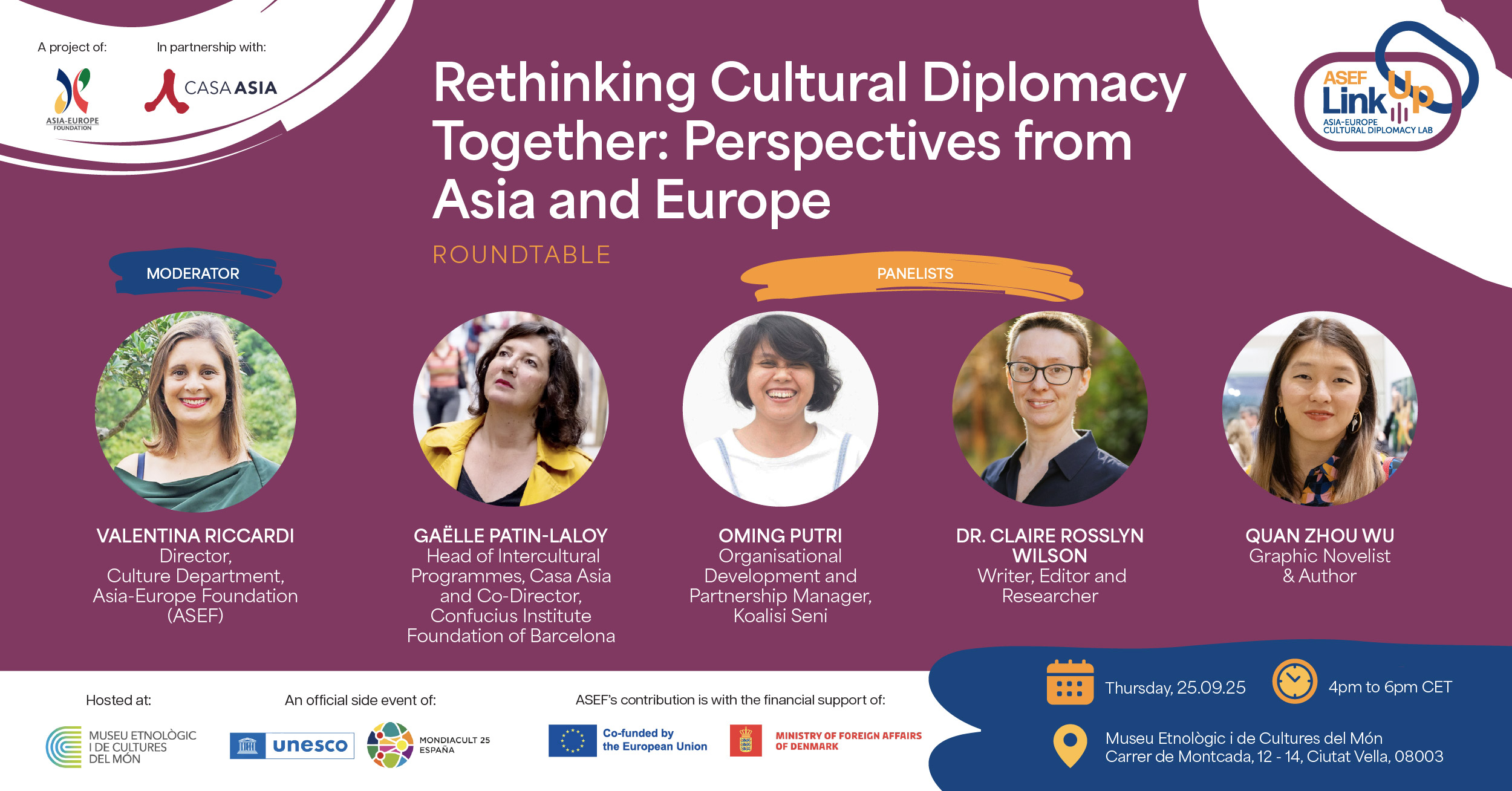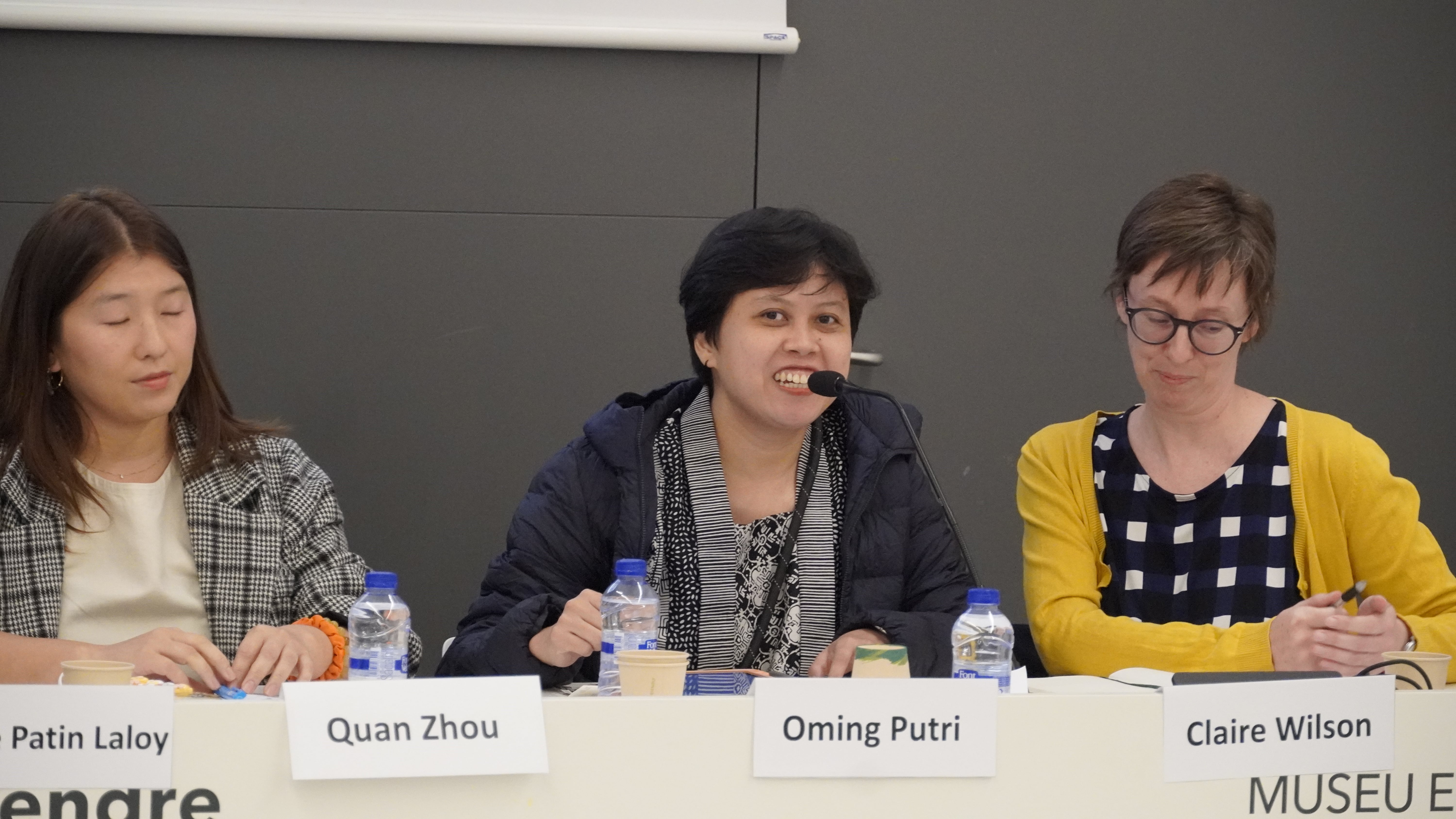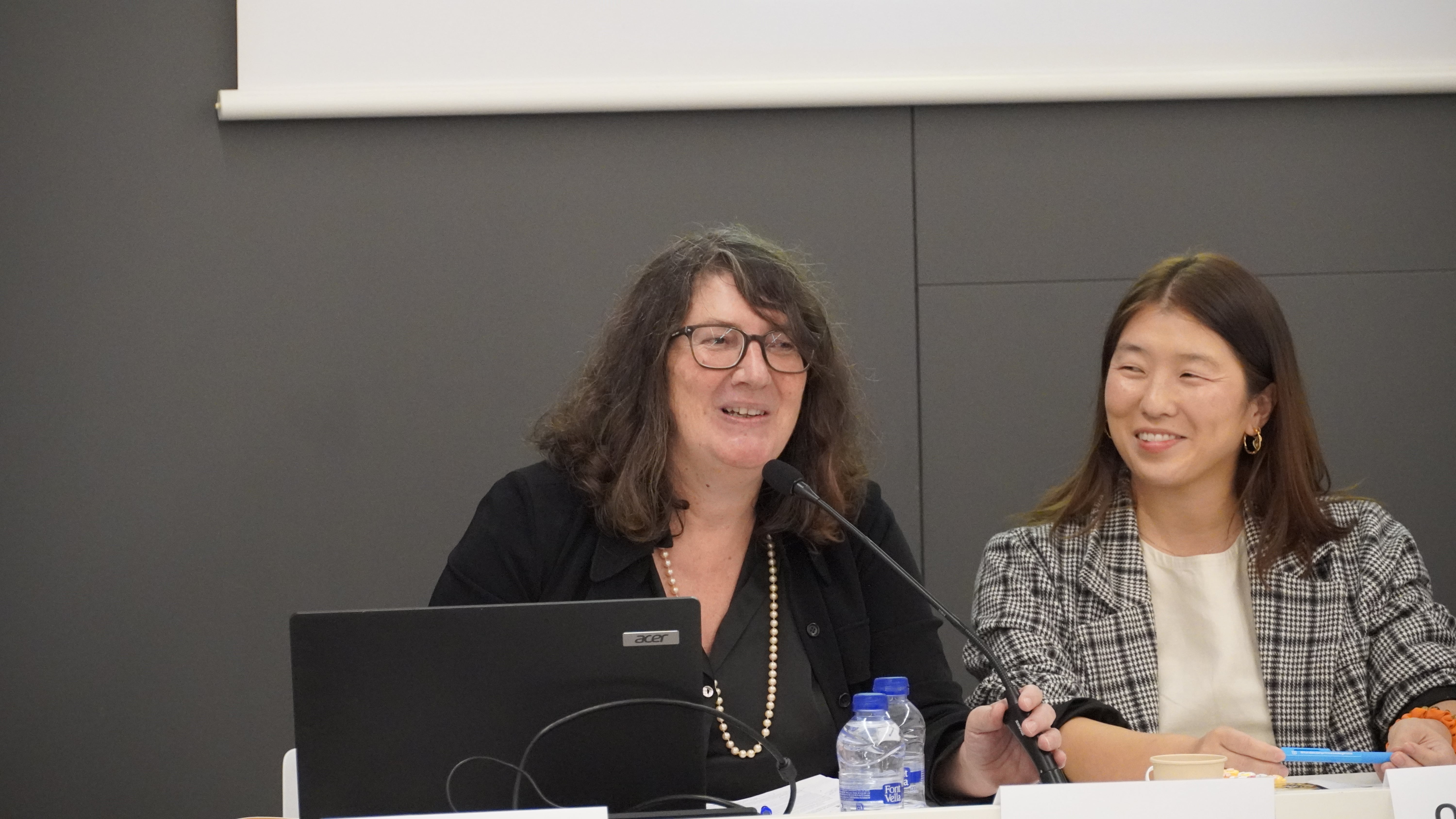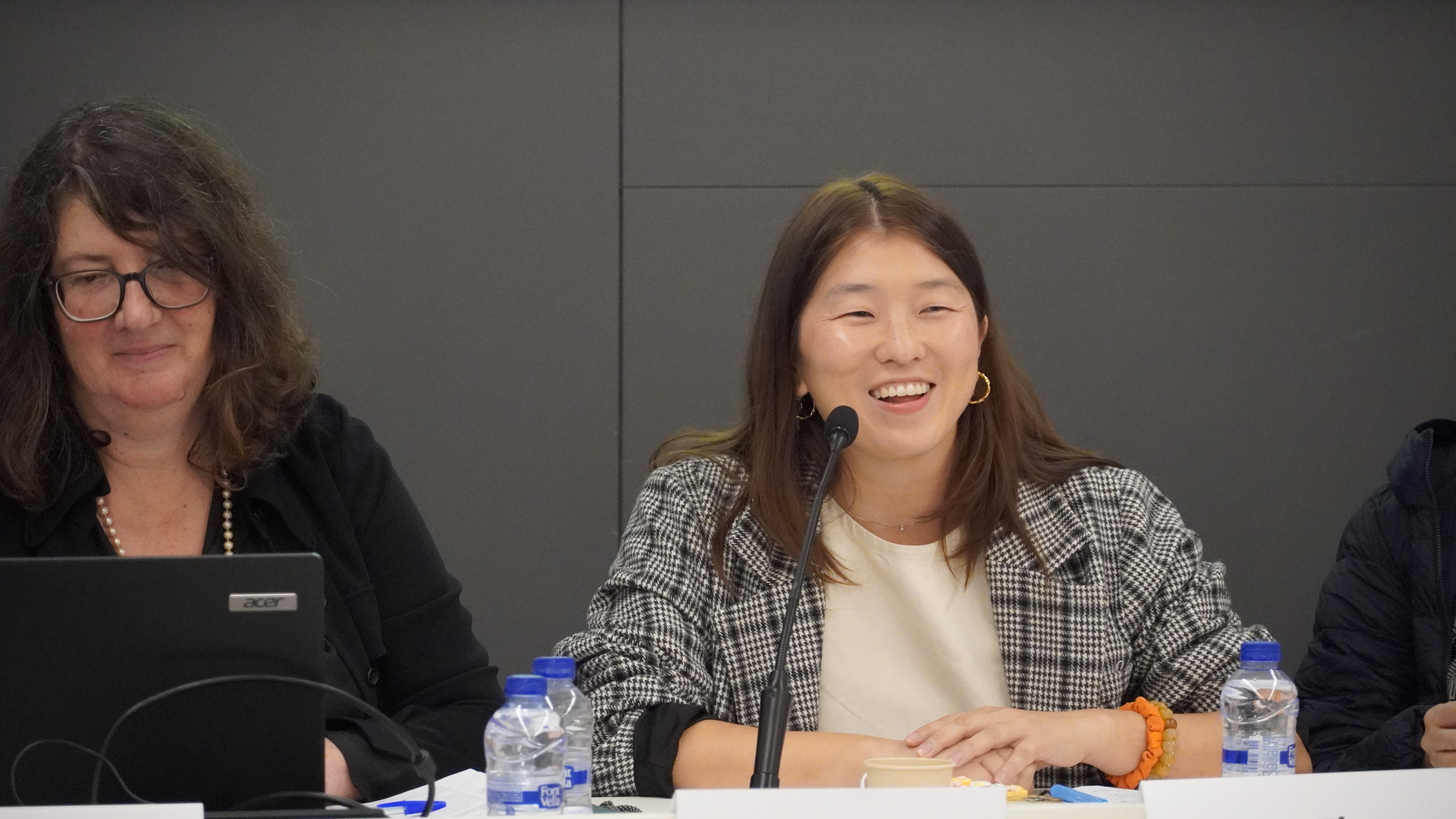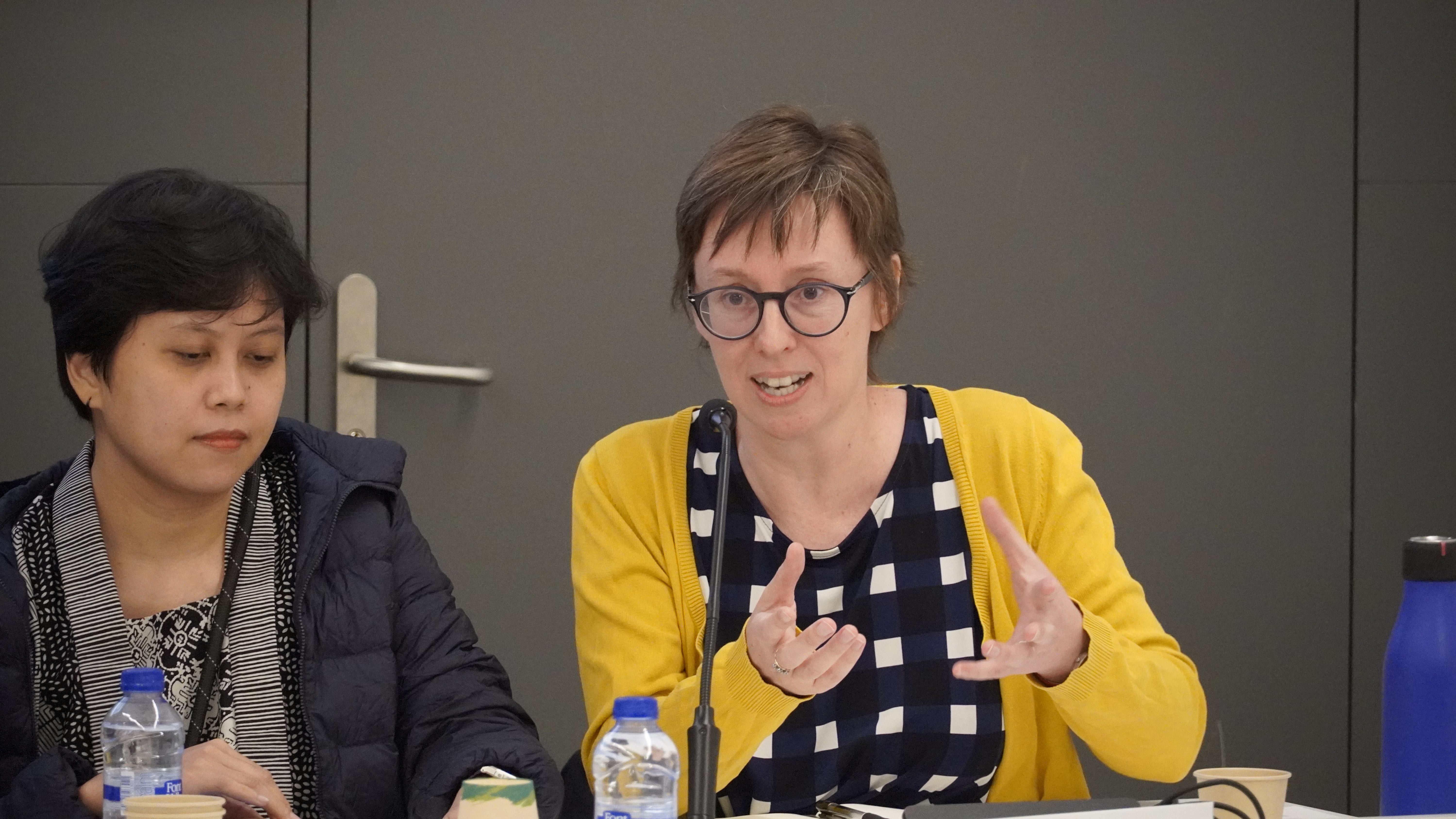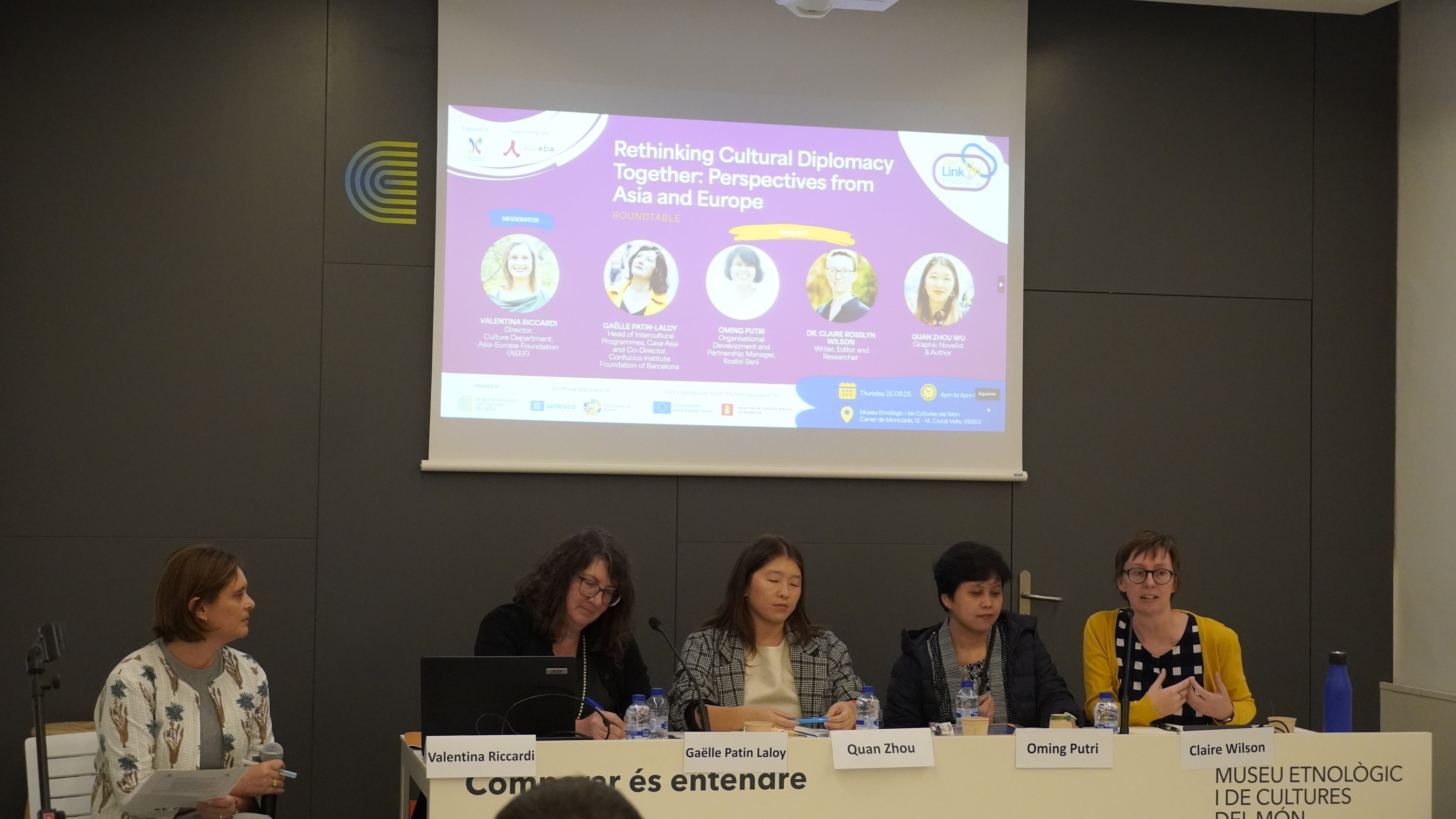ASEF LinkUp Roundtable: A Collective Effort in Rethinking Cultural Diplomacy
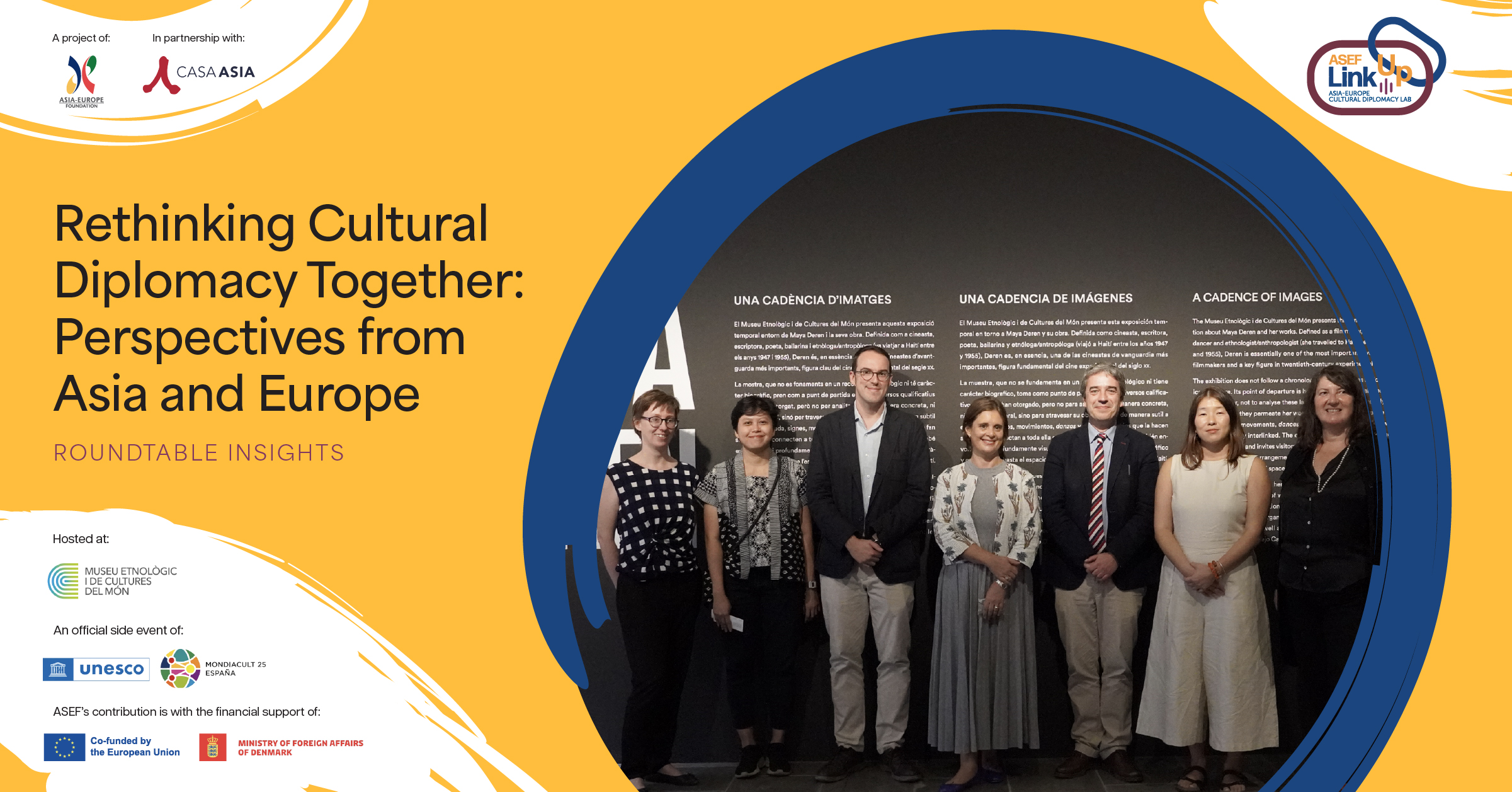
On 25 September 2025, the ASEF LinkUp Roundtable ‘Rethinking Cultural Diplomacy Together: Perspectives from Asia and Europe’ took place at the premises of Museu Etnològic i de Cultures del Món in Barcelona, Spain, as a side event contributing towards MONDIACULT 2025.
Co-organised with Casa Asia, the roundtable was an inquiry into how cultural diplomacy can move beyond state and institutions to embrace communities, care, and collective responsibility. The conversation was also in close connection with one of the priority topics of UNESCO’s World Conference on Cultural Policies and Sustainable Development, focusing on cultural rights and equitable access.
Building on ongoing conversations from the third edition of ASEF LinkUp | Asia-Europe Cultural Diplomacy Lab in Yogyakarta, Indonesia and the ASEF LinkUp Fieldbook | Yogyakarta Iteration, discussions of the roundtable were framed by the notion of collective responsibility, referring to working across, within and beyond our respective roles, sectors, differences and hierarchies.
Gathering independent and institutional representatives from Australia, China, Indonesia and Spain working in the international cultural cooperation field, the roundtable crossed borders, practices and perspectives to exchange insights on engaging diverse groups in international cultural relations.
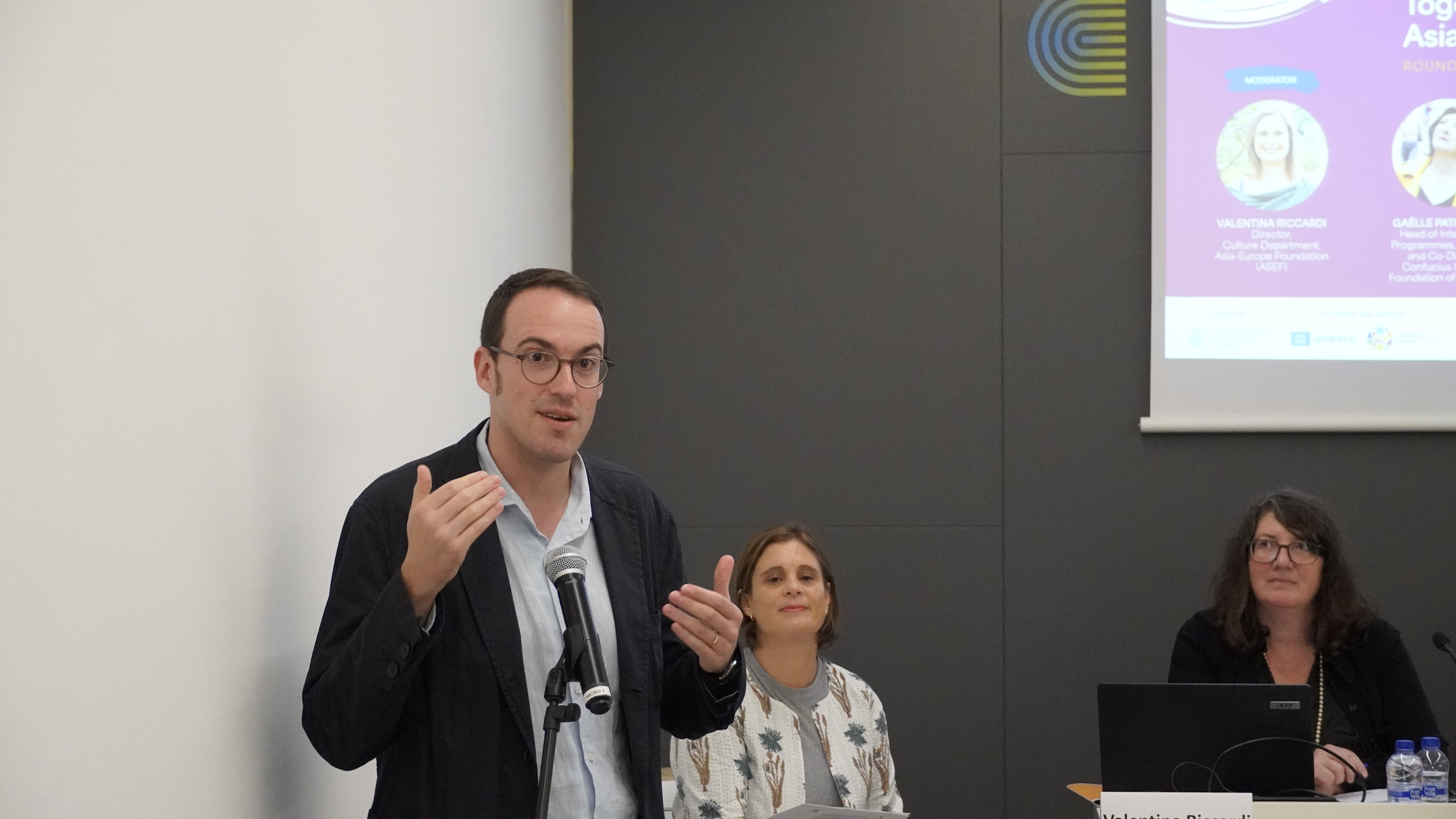 | 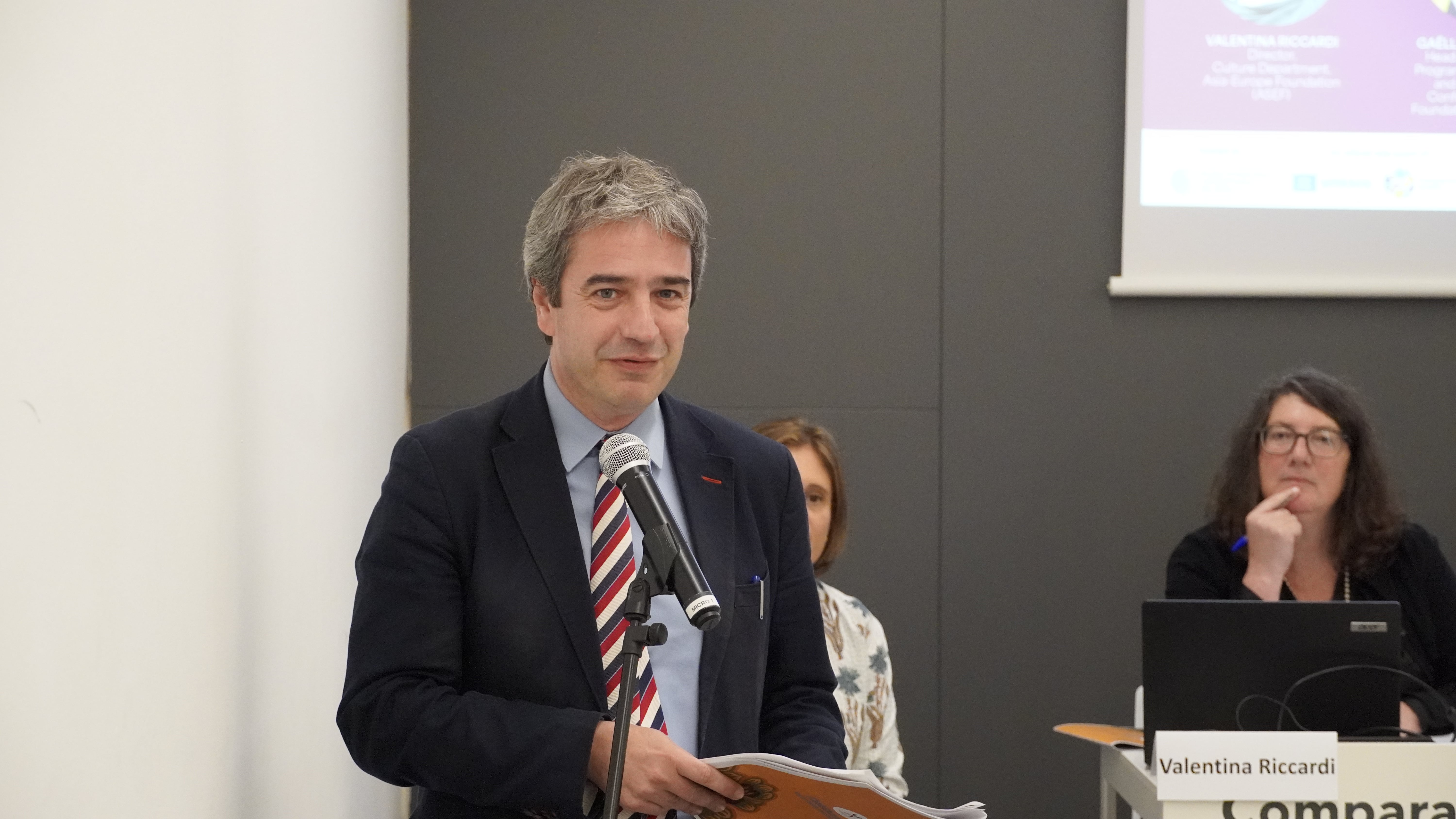 |
1. The roundtable opened with remarks by Jaume Muñoz, Director of Memory, History and Heritage, Institute of Culture, Barcelona City Council (Left) and José Pintor Aguilar, Director General, Casa Asia and ASEF's Governor from Spain (Right). Photo © Asia-Europe Foundation and Casa Asia. | |
Whether you work frequently across borders or are just entering the international arts and culture sector, our roundtable offers the following perspectives when thinking about cultural rights, representation and collective responsibility in cultural diplomacy:
1. “The result of cultural cooperation should be better than if we did something on our own”
The quote above was what stuck with Claire Wilson, Editor, Writer and Researcher in International Cultural Cooperation, when reflecting on her experience facilitating the second edition of the ASEF LinkUp | Asia-Europe Cultural Diplomacy Lab.
Implicit in the nurturing of international cultural relations is the principle of fostering partnerships with other actors. There is a synergistic value to the act of working together, where the results of collective engagement and cooperation of two or more stakeholders achieve more than the sum of their individual efforts.
The value of forming, developing and maintaining partnerships was very clear to Oming Putri, Organisational Development and Partnership Manager at Koalisi Seni, a Jakarta based art policy advocacy organisation, who shared examples of this.
Multi-stakeholder collaboration is a strength in advocating for artistic freedom for artists and individuals in Indonesia, the world’s fourth most populous country with over 1,340 ethnic groups. The impact of Koalisi Seni across Indonesia could not be at a large scale without the support of these four stakeholders:
- Local media: On the ground media coverage regarding violations on artistic freedom cases raises public awareness and serves as a source of documentation in recording the violations that occur
- Legal aid organisations: For those experiencing or who have experienced violations to their artistic freedom, the availability of legal knowledge helps artists be aware of their rights
- Fellow activists: Activists who work on both culture and human rights issues facing similar challenges in different countries can form a support network to share practices and solutions more widely
- Government: The advocacy for artistic freedom needs to go hand in hand with legislation and regulations, enforced by the government
The resources, diverse experiences and perspectives of four different partners are thus essential in leading support for artistic freedom in Indonesia.
2. Koalisi Seni's Oming Putri works to advocate for artistic freedom and cultural policy reform, strategically serving as a bridge between stakeholders of the arts ecosystem. Photo © Asia-Europe Foundation and Casa Asia.
2. Building exchanges on a common purpose and reciprocal benefit
Apart from engaging with a breadth of stakeholders, establishing partnerships that extend beyond mere display and instead focus on reciprocity and a shared purpose that all stakeholders care about is key.
Gaëlle Patin-Laloy, Head of Intercultural Programmes, Casa Asia and Co-Director of the Confucius Institute Foundation of Barcelona, shares Casa Asia’s approach in developing its strategic plan for the next four years.
As a public diplomacy organisation promoting international relations between Asia, Pacific and Spain, working groups comprising civil society, public and private institutions across the economic, cultural and educational fields are set up. Insights from their engagements then contribute towards the formulation of Casa Asia’s draft strategic plan – a clear example of bringing stakeholders from different contexts into the same equal space and sharing, while caring about what the other parties want.
3. Head of Intercultural Programmes, Casa Asia and Co-Director of the Confucius Institute Foundation of Barcelona, Gaëlle Patin-Laloy shares Casa Asia's close consultation with its community and stakeholders from diverse backgrounds, to seek views from the wider public for its strategic plan. Photo © Asia-Europe Foundation and Casa Asia.
3. “So when you say cultural diplomacy, who are you speaking to?”
As an independent graphic novelist and author, the roundtable made Quan Zhou think about language and the terminology surrounding the concept of cultural diplomacy.
Speaking from experience, the term cultural diplomacy might resonate amongst academics, politicians and the government sector, but can feel fairly foreign to independent practitioners or the general public.
In this context, making cultural diplomacy more inclusive starts with terms that are easily comprehensible by the wider public and non-specialists in the field, to ensure easy access to understanding what cultural diplomacy means. When communicating about cultural diplomacy, sharing experiences, perspectives and stories in simple language whilst keeping your target audience in mind reduces intimidation and unfamiliarity of the term.
Apart from language accessibility, collective responsibility in cultural diplomacy also includes building one’s vocabulary around the concept.
Claire suggests a resource published by the European cultural mobility network On the Move, titled ‘International Mobility of Artists and Culture Professionals: The Lexicon’, to help bridge understandings about the specificities of the sector. Framed as a dictionary of key terms used in the arts and cultural sector, the resource could be useful in clarifying terminologies and raising awareness of how artistic mobility plays a vital role within the framework of cultural diplomacy.
4. As an independent graphic novelist and author, Quan Zhou shares how language accessibility can bring a sense of collective care into cultural diplomacy. Photo © Asia-Europe Foundation and Casa Asia.
4. Towards inclusive and 'really open' international cultural exchanges
When thinking about collective responsibility in cultural diplomacy, being more diverse and inclusive is an ethos to be translated into practice.
Limited information and knowledge about other international opportunities in Europe and Asia remains a critical barrier to cultural relations. In Asia, there is a more prominent gap owing to defunct websites and outdated information about the arts and cultural sector. As the Editor of ASEF culture360 and Data Collector and Analyst of On the Move, Claire observes that there is still more work to be done in the aspect of sharing information, resources and tools to address these imbalances.
In 2024 over 600 funded mobility opportunities were published on On the Move’s website. Yet, close to 70% of the calls originated from organisers based in Europe. ASEF culture360 saw similar patterns, with 23% of its news, events and opportunities from Asia, 16% related to Europe and 24% connecting the two regions.
Other examples raised during the roundtable include the Artistic Freedom Database, implemented by Koalisi Seni in partnership with UNESCO. The web-platform developed to monitor violations of artistic freedom in Indonesia allows victims, witnesses and support persons to submit direct reports on the website, allowing Koalisi Seni to gather evidence on the ground using a bottom-up and participatory approach.
5. As a freelance editor, writer and researcher in international cultural cooperation, facilitating the open access of information for the arts and cultural sector across borders is central in Claire's work. Photo © Asia-Europe Foundation and Casa Asia.
5. As we try to address imbalances in cross-border cultural relations, where are we standing?
In the same vein of developing inclusive transnational cultural collaborations, demonstrating awareness of one’s positionality is crucial as we attempt to recognise and relate to the contexts and perspectives of others.
Claire quoted Filipino-Australian author Merlinda Bobis:
“Empathy is putting ourselves in the shoes of the other, but they do not become our own shoes.”
While empathy is an ingredient of international cultural collaborations and exchanges, it should come hand in hand with self-reflection and self-awareness. It involves being aware and sensitive about our varying levels of privilege and power, asking ourselves “where are we standing?”, “what have we missed about our privilege or experience that we're saying?”.
6. The weight of representation
While diversifying one’s audiences, participants and partners are increasingly central in debates surrounding international cultural cooperation and are acknowledged as a key factor in more inclusive cultural activities, translating this into action is more challenging in reality.
As explained by Quan Zhou, the raw numbers highlight a great disparity to opportunities for professionals across Spain. Although Spain’s population is close to 50 million people and there is a lot of diversity in the national population, the numbers are not reflective of who gets opportunities in the local arts and cultural sector.
Claire echoes this with her perspective of Australia’s population. Being a diverse country with a long history of migration, almost 30% of the population is born in another country. However, only 6% of those working in the publishing sector are non-Caucasian, in comparison to 32% of the population.
Apart from the numbers, what is also important to consider is the weight of representation.
As cultural organisations consider ways to be diverse and inclusive when working internationally, it is perhaps worth reimagining a more meaningful way to ensure underrepresented groups and minority communities are included, instead of having one or two persons speak on behalf of the marginalised voices.
7. Horizontal, multiplication, transversal
In relation to the point above, Gaëlle proposes three factors to consider for institutions looking to create genuine inclusion and not just symbolic visibility:
- A horizontal and decentralised approach: This ensures that the underrepresented groups and minority communities are meaningfully included into programmes and are not approached in a tokenistic manner
- Multiplication: A single project is not enough. How can the scale, value and longevity of an initial project be increased over time to have a greater, longer-term impact?
- Transversal: This involves cross-sectoral collaborations across departments and issues
6. As part of the ongoing conversations following ASEF LinkUp 2025, ASEF continues to ask: how can cultural diplomacy be reimagined for today's realities? Photo © Asia-Europe Foundation and Casa Asia.
8. Impact, sustainability and looking ahead
While the roundtable helped nuance key issues surrounding collective responsibility and cultural diplomacy, it also sparked food for thought on capturing the impact and long-term value of international cultural exchanges:
- With cultural managers being the main intermediaries in brokering cultural collaborations, could we be looking at how the cultural fluency and competencies of these facilitators have been fostered over time? For instance, measuring how one’s understanding of different societies, cultural nuances, traditions, ways of working and language have changed or developed to quantify the merits of a cultural exchange project.
- Should evaluation of a project be done only six months to a year after a project, giving a longer timeline for artistic, relationship-building and organisational impact to ferment?
- A cultural policy that prioritises creating space for growth and support of the arts and cultural sector. Indonesia’s Law on Advancement of Culture enacted in 2017 offers one model, supporting cultural growth beyond economic impact and gain.
Cultural diplomacy as collective work
The roundtable with its rich discussions made clear that cultural work is collective. As exemplified by the speakers, the examples and ideas raised represent just a small fraction of the many individuals, organisations and initiatives that harness collective responsibility in cultural diplomacy.
It is hoped that the discussions contribute towards further nuancing our understanding of cultural diplomacy. By continuing to which requires sharing and advocating of international experiences, so that others can adopt and extend it to their own contexts.
Watch the recording of the roundtable:
ASEF and Casa Asia would like to thank the following speakers for their valuable contributions to ‘Rethinking Cultural Diplomacy Together: Perspectives from Asia and Europe’:
